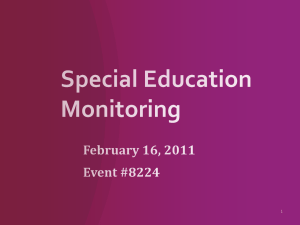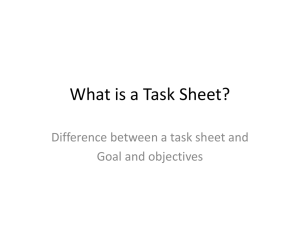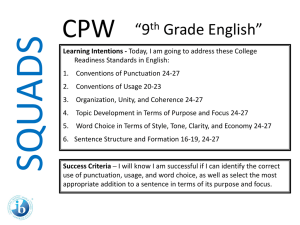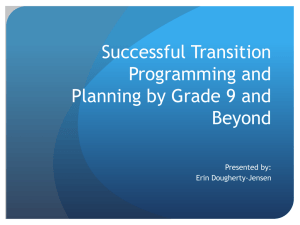Rationale PowerPoint - Walker County Schools
advertisement
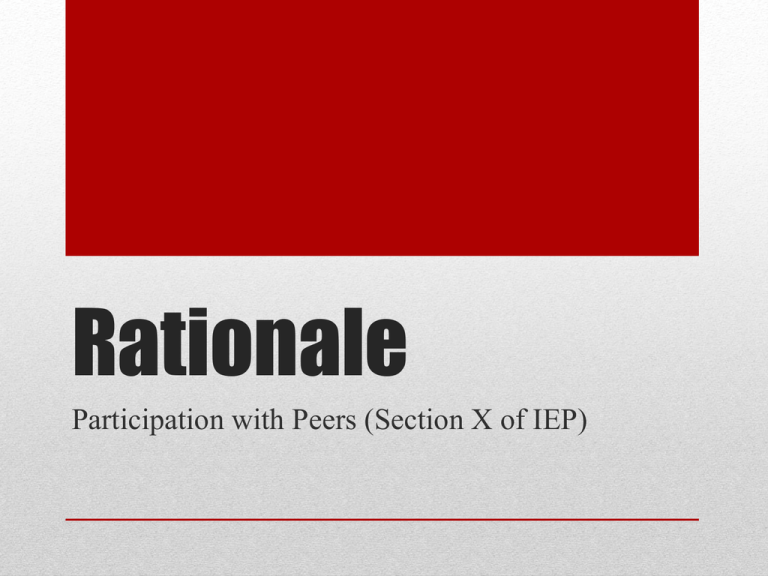
Rationale Participation with Peers (Section X of IEP) • • • • • • Who is responsible for rationale? What is meant by rationale? When is the rationale considered? Where do I document the rationale? Why must I provide a rationale? How do I write a legally defensible rationale? What should I learn? • Caseload Manager responsible for composing rationale • Documents reasoning/consensu s by IEP team members Who? • Definition of Rationale: “Underlying reason.” • What is the underlying reason why this service must be provided in a separate setting? • Why does the student need to be “segregated” from other typical peers in order to receive this service? What? • Do not let the Heading of this section (Participation with Peers) fool you! • Focus on the wording under the heading, “The explanation of the extent, if any, to which the child will not participate with peers without disabilities in the regular class and/or in nonacademic and extracurricular activities:” • Key word here is Explanation (Rationale, underlying reasons) • One of most critical areas of IEP in litigation • Focus of Special Education Monitoring statewide Be Careful! • Section X must always be filled in for every IEP. • If all services are occurring in the general education setting, then you may use the canned statement provided in the Look Up List (magnifying glass icon). • Rationale must be provided for ANY service that is occurring outside of the general education setting. • This also includes related services or supportive services such as speech, OT, PT, special transportation, etc. which are delivered in a pull-out setting. When? Where? • Required to provide services in the Least Restrictive Environment by federal regulations. • Must provide a justification for any removal from general education setting. • May consider student progress and disruption to learning of others in the decision-making process. Why? • Extremely disruptive behaviors that interfere with the learning of other students. • Student has extreme trouble with distractibility and cannot focus on instruction in a large group setting. • Student requires instruction on pre-requisite academic skills that are far below current grade level and will not be covered in the general ed curriculum. • Student requires instruction on skills that are not taught in the general ed curriculum. (example: Braille, sign language, how to use assistive tech equipment, etc.) • Student has not shown progress on critical skills in a less restrictive setting and needs more intensive direct instruction. • Student needs specialized instruction or interventions (ex. stuttering therapy) which might disrupt classroom instruction or cause peer attention/ridicule. • Student requires specialized instruction on functional life skills and works on an access/entry level on the core curriculum; needs instruction in a variety of settings to transfer learning. • Student has special medical, safety, or health needs. Factors that might justify removal to a separate class setting Document: • Characteristics of disability that result in an • Impact on educational performance causing a need for • Specialized Instruction/supports/services that cannot be feasibly provided in the general education setting. • Rationale: Why not? Rationale = Poor: “The IEP team determined this was the least restrictive environment for Susie.” Good: “Due to her Other Health Impairment (ADHD) •characterized by limited attention and distractibility, Susie is •frequently off-task in a large group setting. She •requires a quiet, less distracting environment with frequent feedback in order to remain focused on instruction. •This level of differentiation is not feasible in the general education setting. Therefore, she needs small group instruction in a separate class setting in the critical skill areas of math and language arts.” How? (underlying reason) Poor: “Susie will receive 3 segments a day of separate class instruction in reading, math, and language arts.” Good: “Due to her specific learning disability characterized by •deficits in visual processing, Susie often •has trouble distinguishing between look-alike words, reverses letters/words/numbers, has difficulty copying accurately, and is functioning far below grade level in reading, math, and language arts. She needs •specialized intensive instruction using alternative materials and techniques incorporating different modalities. She also requires instruction on pre-requisite academic skills not covered in the general curriculum for her grade level. •This level of differentiation is not feasible in the general education setting. For these reasons, she will be provided instruction in a separate class setting in the critical skill areas of reading, math, and language arts.” How? (underlying reason) Poor: “Johnny will be with typical peers during Connections and any extracurricular activities during the school day. He will be in a self-contained BD class for all academics.” Good: “Due to his Emotional/Behavioral Disorder characterized by •thoughts and feelings that are inconsistent with actual events, situations, or interactions, Johnny frequently •loses self-control (yells, throws objects, gets out of his seat) and fails to respond to teacher corrections. His maladaptive behaviors result in a need for •frequent and intrusive behavioral interventions which are disruptive to the learning of others. He needs specialized instruction to learn alternative behaviors to replace his maladaptive behaviors. •This level of differentiation is not feasible in the general education setting and his behaviors are disruptive to the learning of other students at this time. For these reasons, he will receive instruction in a separate class setting.” Good: “Due to his diagnosed MOID characterized by •delays in cognitive, academic, and adaptive behavior skills, •Johnny takes longer to learn new concepts and has trouble transferring what he has learned from one setting or type of activity to another. He also has trouble understanding abstract concepts/vocabulary and has trouble learning functional skills that typical peers learn through incidental learning. •He requires direct specialized instruction on functional life skills not covered in the general curriculum for his grade level. He also needs practice in a variety of community settings in order to transfer his learning. •This level of differentiation is not feasible in the general curriculum. Therefore, he needs instruction in a separate class setting.” How? (underlying reason) Good: “Due to his Speech/Language Impairment, characterized by •severe articulation difficulties (multiple omissions/substitutions), •Teachers and peers have trouble understanding what Johnny is saying. He is quiet and reluctant to participate during classroom discussion and has to repeat himself multiple times to make himself understood. •He requires specialized instruction by an SLP in a quiet, distractionfree environment so that he can hear the models provided by the speech therapist and receive immediate feedback. •This level of differentiation is not feasible in the general education environment. For these reasons, he requires separate class services during speech therapy.” How? (underlying reason) Good: “Because of Susie’s specific learning disability characterized by •processing deficits in phonological awareness, •she has trouble identifying unfamiliar words using phonetic analysis or syllabication. •She is currently more than two years below her present grade placement. •Due to her lack of progress toward her goals in the critical area of reading, •she needs more intensive interventions in a small group setting using highly specialized instructional techniques. •This level of differentiation is not feasible in the general education environment. For these reasons, she will receive separate class services in the critical skill area of reading.” How? (underlying reason) Good: “Due to her medical condition characterized by •fluctuations in blood oxygen levels, •Susie’s blood oxygen levels can drop dangerously low, presenting a safety risk for her health and life. •She needs special transportation services, providing oxygen and a trained bus aide to monitor her medical needs. •This level of support is not available on a regular bus. Therefore, she will be provided special transportation services. ” How? (underlying reason) • Who? • Special Ed Caseload Manager • What? • Underlying reason. • When? • Every IEP. • Where? • Section X of IEP Services page. • Why? • Required by law. • How? • Explain or justify the underlying reasons*. Rationale Questions?

